Advertisements
Advertisements
प्रश्न
With the help of suitable diagrams, explain the five stages of prophase-I of meiosis.
उत्तर
Prophase I is the longest phase of meiosis and is further sub divided into 5 phases:
- Leptotene

Condensation makes chromosomes become distinct and compact. - Zygotene

Homologous chromosomes start pairing together by a process called synapsis to form a complex structure called synaptonemal complex. Two synapsed homologous chromosomes form a complex called bivalent or tetrad. - Pachytene

Longest phase of prophase I
Recombination nodules appear in this stage at the sites where crossing over has to take place between non-sister chromatids of homologous chromosomes. - Diplotene

Synaptonemal complex dissolves and recombinants separate from each other except at crossover sites to form X-shaped structure called chiasmata. - Diakinesis

Chiasmata terminalises and chromosomes condense. Meiotic spindle assembles and nucleolus and nuclear envelope disappear.
APPEARS IN
संबंधित प्रश्न
The diagram given below represents a certain stage of mitosis:
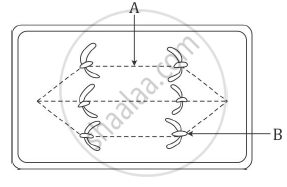
- Identify the stage of cell division.
- Name the parts labelled A and B.
- What is the unique feature observed in this stage?
- How many daughter cells are formed from this type of cell division?
Given below is a diagram representing a stage during mitotic cell division in an animal cell Examine it carefully and answer the questions which follow.
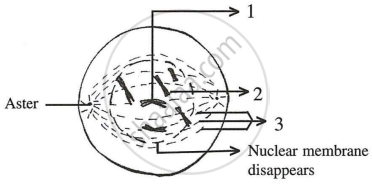
- Identify the stage. Give one reason in support of your answer.
- Name the cell organelle that forms the ‘aster’.
- Name the parts labelled 1, 2 and 3.
- Name the stage that follows the one shown above; how is that stage identified?
- Mention two differences between mitosis and meiosis with regards to:
- The number of daughter cells produced.
- The chromosome number in the daughter cells.
Fill in the blank and explain the statement.
For formation of plasma membrane, ____________ molecules are necessary.
The fig given alongside shows a certain stage in a cell division in a cell with four chromosomes.
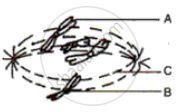
(i) Name the parts of the chromosome labeled A and B.
(ii) Name the structure C. what is its function?
(iii) Name the type of division . Give a reason.
(iv) Name the stage of division.
(v) Name the stages before and after the stage shown in diagram.
The diagram below represents a certain stage of a cell.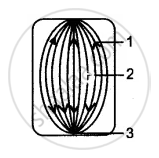
(i) Is it an animal cell or a plant cell ? Give one reason in support of your answer.
(ii) Label the parts numbered 1 – 3.
(iii) Which stage (phase) of mitosis is represented in this diagram
Name the following:
Replacement of dead cells is accomplished by which process.
Name the Following
Name the stage during which nuclear membrane and nucleoli reappear.
Give Technical Terms
The stage at which spindle fibres begin to be formed.
Complete the following sentence with appropriate word :
Colchicine arrests cell division at __________.
Choose the Odd One Out
Multiple Choice Question:
The nuclear membrane disappears in
Multiple Choice Question:
The nuclear membrane and nucleolus become indistinguishable during
The karyotype (set of chromosomes) shown below is taken from a dividing cell in a certain individual.
(i) Is the individual male or female? Explain your answer.
(ii) How would you expect
(a) a female cell and
(b) sperm cell to differ in chromosome composition?
Explain the following figure.

Identify the stage of mitosis from the below picture. List the chromosomal events in this stage.
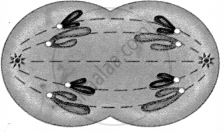
The phase of karyokinesis which is almost the reverse of prophase is ______.
